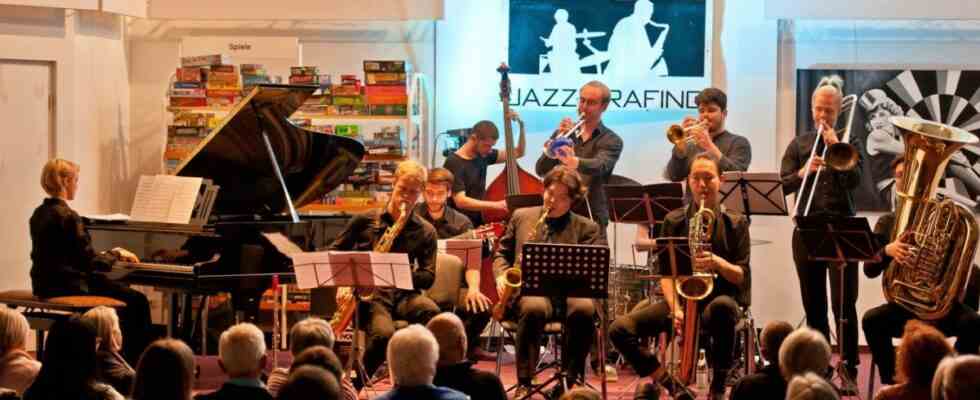No, the title is not intended to indicate a scathing, but as a motto it spanned the Saturday evening in the Grafing public library with the one led by Martin Zenker Charles Mingus Ensemble. Only music by the namesake was performed, whose music was often described as uncomfortable, bulky and unruly. The band leader stated that one shouldn’t even try to understand them, because as in the case of Mozart or Bach, for example, no one can completely examine these geniuses anyway – and music shouldn’t be there to understand them, rather they want to Trigger emotions and move us. On April 22, Mingus would have been 100 years old and Jazz Grafing also celebrated his birthday in April. The International Jazz Day initiated by UNESCO also took place on the day of the concert: three reasons for this concert.
The sheet music had to be transcribed from the original recording
The focus of the gig was Mingus’ Magnus opus “The Black Saint and The Sinner Lady”, that legendary recording about which he said: “Forget all my other records”. Sheet music for this four-movement suite was never published; for performances with the ensemble, it had to be transcribed from the original 1963 recording and in some cases rearranged. The Black Saint and The Sinner Lady is a symphonic work in which through-composed passages appear again and again, which structure the otherwise free journey through the transverse sound worlds.
Significant are the dense, deliberately shrill, dissonant wind sections and the intensity that can hardly be surpassed with continuous accellerandi, which in Grafing, especially in the second movement, literally pulled the rug out from under the listeners’ feet and let them fall into a trance. After the first movement there was above all a respectful applause in the Grafing public library, which was sold out to the last seat. In the second movement, the audience thawed, warmed up to the music, grooved and enthusiastically cheered along.
The band of eleven, made up of students from the University of Music and Performing Arts in Munich, had obviously dealt with this music in depth and fused the flair of Mingus’ original with the sparkling creativity of the present.
Unfortunately, the guitarist can only be heard when the wind instruments are silent
According to the impression of the evening, the ensemble could be categorized into three groups, which made possible contrasts and lively dialogue through their different approach: Vincent Rein on bass and Nathan Carruthers on drums fired the band from the last row with their energetic playing, visually underlined through dance to trance-like movements, acoustically through the sensitive and parallel impulsive play. Rein led vocal lines, never left the bass purely an accompaniment function and gave the band volume from the depths; Carruthers listened to every apparently casual sound and tuned it to the band, weighing not only the rhythms but also the very concrete sound event in relation to the music being played.
The piano and guitar section made a more objective visual impression, but was no less concerned with the full, multi-layered sound. Unfortunately, Simon Harscheidt on the guitar was rarely heard, namely when the wind instruments were silent. During this time, however, he convinced with polyphonic, rhythmically precise music and the fine play with different styles. Marina Schlagintweit was constantly listening and recording in order to be able to react musically to what she had experienced; The fact that the piano only has a filling function for long stretches did not stop her from meticulously shaping even these passages and so well thought-out piano fills flashed up again and again between the wind sections. In the long solo passages she didn’t try to show off in the limelight, but enchanted with pleasant restraint.
Other hits penned by Mingus follow in the second half
In view of Mingus’ dense spelling, it is difficult to sound out the seven wind instruments, as they formed a clear unit. Otgonbaatar Amgalanbaatar captivated with wild alto saxophone solos, which always remained unpretentious and, above all, jokingly robbed the final effect, so even the last note of the approximately 45-minute suite The Black Saint and The Sinner Lady abruptly dissolved into nothingness. Nico Siebeck not only spurred on the tenor saxophone and the flute, but also encouraged the audience and the band with cheeky announcements. Khasar Ganbaatar on the bass saxophone used recurring motifs to create form for the band. The trumpeters Nico Weber and Lukas Tutert dialogued between harshly wild and voluptuously tender. Michael Haas mastered it with virtuosity, while the trombone was cleanly intoned, and Fabian Graf filled the wind section from the depths with the tuba, mixing brilliantly with the other wind instruments, which were naturally harder in terms of sound.
In the second half, a number of other hits penned by Charles Mingus were presented, some with a full band, some with a thinned-out band – Enji Erkhem contributed a surprising vocal number with feeling and admirable intonation of all blue notes. Martin Zenker just misread the gradually tiring audience when, after two and a half hours, instead of condensing the set list, he let the play continue for more than half an hour plus an encore. This did not go against the overall effect of the evening, since the partly similarly knitted forms and wind sections were exhausted at this point and in the end aroused little curiosity. However, the eleven students on stage stayed fit, giving their all from the first to the last note and glowingly demonstrating their skills and their lively, rebellious creativity.

